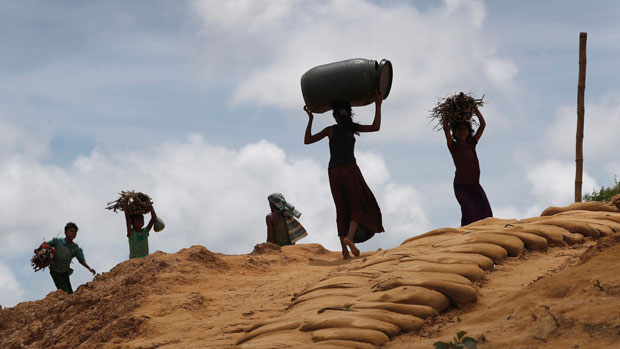Myanmar, Laos Drop in Rank in Annual US Human Trafficking Report
Source: RFA
The U.S. State Department downgraded Myanmar and Laos to Tier 3, its lowest ranking, in an annual report on human trafficking released today, citing the countries’ failure to make significant efforts to combat the trade.
The annual Trafficking in Persons (TIP) report ranks 188 countries as Tier 1, Tier 2, Tier 2 Watch List, or Tier 3, based on whether they meet the minimum standards to combat trafficking set by U.S. law.
In Myanmar, called Burma in the report, the displacement by the national army last year of hundreds of thousands of Rohingya and other ethnic minority groups left many at an “increased risk of trafficking,” the report said.
Some were trafficked for sex or labor at home, with others exploited in neighboring countries in the region, according to the report.
“There were [also] reports that government officials were complicit in both sex and labor trafficking, including by hindering law enforcement efforts against the perpetrators,” the report said.
Meanwhile, the forced recruitment of child soldiers continued in Myanmar during the year, with government authorities punishing former child soldiers for “desertion, alleged fraud, and defamation,” according to the report.
In Laos, though government officials took steps during the year to investigate and prosecute “a modest number of traffickers,” their efforts failed to raise the country above their previous year’s ranking of Tier 2 Watch List.
“And because it has been on Tier 2 Watch List for four consecutive years, it is no longer eligible for that ranking and was therefore downgraded to Tier 3,” the State Department said in its report.
Tier 2 Watch List countries do not fully comply with the minimum standards set by U.S. law but are seen as making significant efforts to do so.
Like other countries covered in the report, Laos remains a source, destination, and transit country for women, children, and men “subjected to sex trafficking and forced labor,” the State Department said.
“A large number of victims, particularly women and girls, are exploited in Thailand’s commercial sex industry and in forced labor in domestic service, factories, or agriculture,” with Lao men and boys forced to work in Thai fishing fleets or on construction sites.
Lao government efforts to identify and help Lao trafficking victims returning from other countries were hindered by “lack of awareness among front-line officers and insufficient border security measures,” the report said.
Other countries
Four other countries covered by RFA—Cambodia, China, North Korea, and Vietnam—received ratings unchanged from last year’s report, with China and North Korea ranked lowest at Tier 3, and Cambodia and Vietnam ranked at Tier 2.
Cambodia remained at Tier 2 for the third year in a row after moving up from the Tier 2 Watch List in 2016. And though Cambodia’s government prosecuted and convicted more traffickers during the reporting period, minimum standards were still not met “in several key areas,” the State Department said.
“Endemic corruption continued to impede law enforcement operations, criminal proceedings, and victim service provision,” according to the report.
“Against a backdrop of insufficient government oversight and accountability measures, unscrupulous business owners subjected thousands of men, women, and children throughout the country to debt bondage in hard labor with minimal interference—and sometimes assistance—from Cambodian authorities.”
Vietnam, also ranked at Tier 2, made efforts during the year to meet the minimum standards set to eliminate trafficking, but also failed in several key areas, according to the report, which cited poor coordination among government agencies and the dropping of ongoing criminal cases due to confusion over relevant laws.
“[And] despite continued reports of official complicity, the government did not report any investigations, prosecutions, or convictions of officials complicit in trafficking offenses,” the State Department said.
Meanwhile, traffickers, some posing as police officers, increasingly use social media to “lure potential victims into vulnerable situations,” the report said.
Worst of the worst
Still ranked from last year at the bottom at Tier 3 in this year’s report, China and North Korea neither fully met “the minimum standards for the elimination of trafficking” nor made “significant efforts to do so,” the State Department said in its report.
Breaking with its practice in previous years, China’s government did not report having identified any trafficking victims or referring them to protective services, and sometimes returned foreign trafficking victims to their abusers, the report said.
China’s internal migrant population of over 180 million is especially vulnerable to trafficking, “with Chinese men, women, and children subjected to forced labor in brick kilns, coal mines, and factories,” the State Department said.
Using combinations of fraudulent job offers, debt bondage, and threats of physical harm, traffickers also take Chinese women and girls to large cities from their rural homes, forcing them into lives of prostitution, according to the report.
Meanwhile, North Korea maintains a profitable system of forced labor in prison camps to “fund government functions as well as other illicit activity,” the State Department said, adding that government repression “has prompted many North Koreans to flee the country in ways that made them vulnerable to human trafficking in destination countries.”
Refugees forced back to North Korea are often held in interrogation centers where they are “subjected to forced labor, torture, forced abortions, and sexual abuse by prison guards,” the State Department said.

